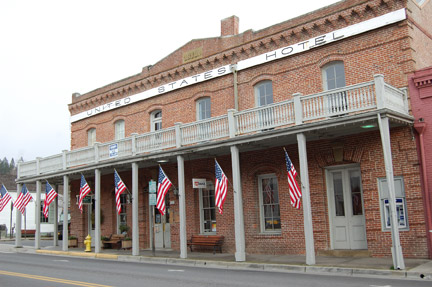This from Jacksonville resident and HARC member, Gary Collins, AIA in response to Tony Boom’s January 14, 2015 article in Mail Tribune.
The old U. S. Hotel may, indeed, have condition problems, as identified in the front page article by Tony Boom on the old brick lady and her structural issues as alleged by concerned citizen Larry Smith in the Wednesday, January 14 issue of the Medford Tribune. They are not likely unique to the hotel, however.
Doubtless some deterioration exists, as it does in all the old buildings in Jacksonville, especially the brick ones. The hotel is not alone in this, and despite our city’s history of dedicated preservation, similar negative conditions exist throughout our stock of old brick buildings. Unfortunately, although the authority to force correction of these exists in our preservation code, Title 18, and in applicable case law, the will to force conformance has never “matured” here. We have so far depended upon the goodwill of owners and operators, with the result that the most common improvement attempted on our ancient brick structures has been repointing of masonry joints. The material exception is the voluntary engineered stabilization of the foundation at Scheffel’s Toys at California and Oregon Streets (the old M3 Brothers Store), accomplished with some support from the HARC by its grant of assistance from the city’s Historic Preservation Fund. Several thousand dollars have been granted from the HPF over the last several years for the aforementioned repointing of other brick buildings and sundry other improvements of structures around town.
As mentioned in Boom’s piece, the County of Jackson owns the building, and is the most financially capable resource the city could look to for correction of any deficiencies, especially those resulting from deferred maintenance. The problem is so common in this city, however, that they should not be singled out as a whipping boy for failure to correct deficiencies. Insofar as the HARC is concerned, its purview is limited to exterior appearance and only those related conditions detrimental to a building’s structural integrity, especially those endangering public safety—when they are specifically known. The HARC is not itself charged with actively identifying otherwise unknown detrimental conditions outside requests for assistance from owner-applicants for monetary grants to assist with the cost of improvements, or specific complaints formally filed with the city by a citizen. The city itself lacks any consistent mechanism for pre-emptively identifying and pursing complaints of “demolition by neglect” (the language of the code), and has no history to-date of doing so. If neglect is egregious, the city council can of course resort to “eminent domain,” but it has never (insofar as this author is aware) applied that recourse to-date. There exists a fundamentally derelict wood-frame historic building here in town which may be a good candidate for doing so.
The best, most stylistically authentic, and most stable masonry building in town is the old County Courthouse, now owned by the city, and it is in process of being structurally retrofitted for greater seismic resistance, and provided with a fire sprinkler system. It now has an owner both capable of preserving it and dedicated to that mission. Via both public funds and various grants, it will fairly soon be returned to public occupancy and community use, the most reliable way to insure its physical preservation and its iconic status as a powerful anchor for the historic imagery of the city.
The U.S. Hotel likely has no more serious condition issues demanding urgency than many other structures in town. The greatest value of the Trib article may be in drawing attention to deficiencies in ALL historic buildings in town, especially the unreinforced masonry ladies on California Street. In particular, they all share a singular liability—leaky stone foundations which are not likely to perform well in the next major quake —especially where they surround basement space. Several of the buildings are also vulnerable “soft story” structures with slender first-level (unreinforced!) brick masonry columns supporting massive facades.
There currently exists no public nor private plan for retrofitting any of the privately owned masonry buildings against a major seismic event. The cost of doing so will be high, and whether there exists the public will to pursue a remedy which could preserve the heart of the town against looming demolition at nature’s hand is an open question.
Gary R. Collins, AIA

Well stated and thank you for taking the time to write this excellent overview.